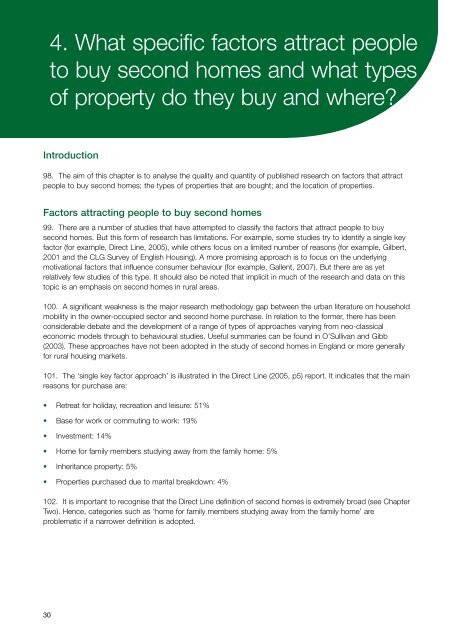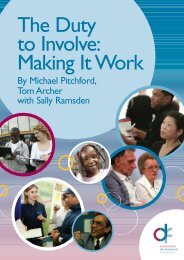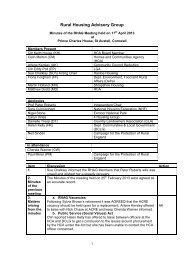Rapid Evidence Assessment of the Research ... - Rural Housing
Rapid Evidence Assessment of the Research ... - Rural Housing
Rapid Evidence Assessment of the Research ... - Rural Housing
Create successful ePaper yourself
Turn your PDF publications into a flip-book with our unique Google optimized e-Paper software.
<strong>Rapid</strong> <strong>Evidence</strong> <strong>Assessment</strong> <strong>of</strong> What <strong>the</strong> <strong>Research</strong> specific factors Literature attract on people <strong>the</strong> Purchase to buy and second Use homes <strong>of</strong> Second and Homes what types <strong>of</strong> property do <strong>the</strong>y buy and where?<br />
Introduction<br />
98. The aim <strong>of</strong> this chapter is to analyse <strong>the</strong> quality and quantity <strong>of</strong> published research on factors that attract<br />
people to buy second homes; <strong>the</strong> types <strong>of</strong> properties that are bought; and <strong>the</strong> location <strong>of</strong> properties.<br />
Factors attracting people to buy second homes<br />
99. There are a number <strong>of</strong> studies that have attempted to classify <strong>the</strong> factors that attract people to buy<br />
second homes. But this form <strong>of</strong> research has limitations. For example, some studies try to identify a single key<br />
factor (for example, Direct Line, 2005), while o<strong>the</strong>rs focus on a limited number <strong>of</strong> reasons (for example, Gilbert,<br />
2001 and <strong>the</strong> CLG Survey <strong>of</strong> English <strong>Housing</strong>). A more promising approach is to focus on <strong>the</strong> underlying<br />
motivational factors that influence consumer behaviour (for example, Gallent, 2007). But <strong>the</strong>re are as yet<br />
relatively few studies <strong>of</strong> this type. It should also be noted that implicit in much <strong>of</strong> <strong>the</strong> research and data on this<br />
topic is an emphasis on second homes in rural areas.<br />
100. A significant weakness is <strong>the</strong> major research methodology gap between <strong>the</strong> urban literature on household<br />
mobility in <strong>the</strong> owner-occupied sector and second home purchase. In relation to <strong>the</strong> former, <strong>the</strong>re has been<br />
considerable debate and <strong>the</strong> development <strong>of</strong> a range <strong>of</strong> types <strong>of</strong> approaches varying from neo-classical<br />
economic models through to behavioural studies. Useful summaries can be found in O’Sullivan and Gibb<br />
(2003). These approaches have not been adopted in <strong>the</strong> study <strong>of</strong> second homes in England or more generally<br />
for rural housing markets.<br />
101. The ‘single key factor approach’ is illustrated in <strong>the</strong> Direct Line (2005, p5) report. It indicates that <strong>the</strong> main<br />
reasons for purchase are:<br />
• Retreat for holiday, recreation and leisure: 51%<br />
• Base for work or commuting to work: 19%<br />
• Investment: 14%<br />
• Home for family members studying away from <strong>the</strong> family home: 5%<br />
• Inheritance property: 5%<br />
• Properties purchased due to marital breakdown: 4%<br />
102. It is important to recognise that <strong>the</strong> Direct Line definition <strong>of</strong> second homes is extremely broad (see Chapter<br />
Two). Hence, categories such as ‘home for family members studying away from <strong>the</strong> family home’ are<br />
problematic if a narrower definition is adopted.<br />
30<br />
4. What specific factors attract people<br />
to buy second homes and what types<br />
<strong>of</strong> property do <strong>the</strong>y buy and where?






